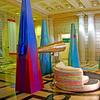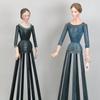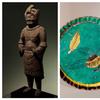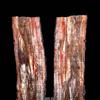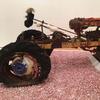Schneider/Erdman Printer’s Proof Collection of Iconic 1980s and ’90s Photographs Acquired by Harvard Art Museums
- CAMBRIDGE, Massachusetts
- /
- May 11, 2017
The collection, additional related works, and an ongoing relationship with Gary Schneider and John Erdman establish the Harvard Art Museums as a principal repository for the artists’ work. The Harvard Art Museums have acquired an unparalleled collection of 443 printer’s proof photographs from Gary Schneider and John Erdman, establishing the museums as a primary site for the study, research, exhibition, and interpretation of contemporary photography. The collection will be featured in the exhibition Analog Culture: Printer’s Proofs from the Schneider/Erdman Photography Lab, 1981–2001, opening in May 2018 at the Harvard Art Museums.
In addition to this transformative collection, the artists have gifted the Schneider/Erdman Archive of photography, test prints, glass plate negatives, vintage material, and records from their Manhattan-based photography printing business, Schneider/Erdman Inc., as well as 30 European modernist photographs from their personal collection. These works, the recent oral histories conducted with Gary Schneider, John Erdman, and their collaborators, and an ongoing relationship with the artists will help establish the Harvard Art Museums as a principal repository for studying Schneider and Erdman’s work and process.
“We are extraordinarily lucky to have such a deep and strong relationship with these two thought-provoking artists and master craftsmen,” said Martha Tedeschi, the Elizabeth and John Moors Cabot Director of the Harvard Art Museums. “Through their generosity and commitment, Gary and John have helped preserve the knowledge and processes of photographic printmaking in the 1980s and ’90s for the benefit of generations to come.”
She added: “Not only have they provided exceptional works of art and flawless examples of the craft of printing photographs, but Gary and John also continue to be inspiring teachers, actively supporting our teaching and learning mission by leading trainings and workshops that invite students and scholars to explore American photography from this period. Together, the printer’s proof collection and the active involvement of the artists are truly transformative for the museums.”
The Harvard Art Museums’ relationship with Gary Schneider and John Erdman began in the late 1990s, when Deborah Martin Kao, the former Richard L. Menschel Curator of Photography, discovered Schneider’s photographic work. Calling him “one of the most thought-provoking photographers working today,” Kao organized the 2004 exhibition Gary Schneider: Portraits, which explored the artist’s innovative methods and his fascinating evolution in thinking about the nature of photographic portraiture. While collaborating with Schneider for the exhibition, Kao learned of Schneider’s career as a printer of photographic works and of the extraordinary collection of printer’s proofs that he and his partner, John Erdman, had accrued as part of the business they founded together in 1981.
Originally trained as an artist, Schneider developed a philosophy that facilitated remarkably effective collaborations with a wide range of artists and institutions when he began to work as a master printer of photographs. In all of his collaborations, Schneider sought to “catalyze the vision” of his clients. Rather than printing in his own style or with a standard set of methods, he approached each project on an individual basis. In order to facilitate the working process, and in partial exchange for their printing services, Schneider and Erdman adopted the standard printmaking practice of retaining a printer’s proof, a print set aside from each edition of photographs that they made. In the context of Schneider’s collaborative approach, the printer’s proof crystallizes the outcome of a series of decisions, arrived at by Schneider and his clients, and expressed through a precise combination of papers, toners, and other techniques specific to each photograph.
Over the course of three decades, Schneider and Erdman’s printer’s proof collection grew to represent hundreds of works of art by many of the most significant and influential artists of the day, including Richard Avedon, Matthew Barney, Peter Campus, James Casebere, Louise Dahl-Wolf, Eric Fischl, Robert Gober, Nan Goldin, Peter Hujar, Mary Ellen Mark, Gilles Peress, John Schabel, Lorna Simpson, and David Wojnarowicz, among many others.
“This is quite literally about preserving a time in history,” said Kao, who recently stepped down as chief curator at the Harvard Art Museums. “The 1980s were defined by the explosion of the medium as a form of both high cultural commodity and incisive cultural critique. Both tangents are represented in the Schneider/Erdman Printer’s Proof Collection. The acquisition of this pristine collection is significant for the way it allows the Harvard Art Museums to represent American contemporary photography during a pivotal era; and the additional gift of archival materials from Gary and John signals a true commitment to preserving their meticulous artistic process for the benefit of students and scholars, and the wider community.”
Schneider describes the printer’s proofs as a “true study collection.” “It’s exciting for us that the collection will be protected here,” he said. “When we talked to the artists represented in the collection, we told them that the proofs would be seen and used, and would be conserved and handled correctly; the artists were thrilled.”
The Harvard Art Museums acquired part of the collection through a combined purchase and gift in 2011, followed by a second acquisition of the remainder of the collection in late 2016. The newest gifts—the Schneider/Erdman Archive, conservation materials, and the collection of German and Czech modernist photography—came in 2017, while another gift of photographs is expected in 2018.
“It was always our goal and our desire to have the printer’s proof collection come to Harvard; but it was a long process, and we never would have guessed that it would finally find its way here along with so much of our supporting work,” said John Erdman. “We’re most excited about the educational purposes that these collections and their location at the Harvard Art Museums will support.”
Schneider and Erdman knew that the Harvard Art Museums would be the right home for the collections after visiting the museums’ Agnes Mongan Center more than two decades ago. The center gave students, scholars, and visitors the opportunity to directly study original works on paper from the Fogg Museum collections to set their own learning goals and chart their own path of inquiry. Today, the expanded Art Study Center continues this tradition through direct, in-person access to original works in all media from all of the museums’ collections.
What Schneider and Erdman observed in the Mongan Center was reminiscent of the way they learned their craft, handling and closely observing a variety of prints through visits to auction houses and flea markets. That process led them to collect modern European prints that educated their eye. The selection of works that Schneider and Erdman recently gifted from their personal collection bolsters the Busch-Reisinger Museum’s current photography holdings.
“These prints—including the first portrait by Bauhaus photographer Lucia Moholy to enter our collection—fit ideally into our existing holdings,” said Lynette Roth, Head of the Division of Modern and Contemporary Art and Daimler Curator of the Busch-Reisinger Museum. “Gary and John have an impeccable eye for and knowledge of photographic print, and they understand the strength of our collections and what we can uniquely do with them.”
For both Schneider and Erdman, the forthcoming exhibition Analog Culture: Printer’s Proofs from the Schneider/Erdman Photography Lab, 1981–2001, together with the years of conversations they have had with Harvard Art Museums curators, conservators, fellows, and students, helped them see that, like their prints, they themselves are repositories of knowledge about a specific period in history.
“One of the most significant outcomes of this project has been the gathering of oral histories from Gary, John, and their collaborators,” said Jennifer Quick, the John R. and Barbara Robinson Family Associate Research Curator in Photography at the Harvard Art Museums and curator of the Analog Culture exhibition. “It has become increasingly apparent that their photography lab is like a prism through which to understand key histories of these years, such as the AIDS crisis and its devastating impact on the art world, the culture wars of the 1980s and ’90s, and the transformation of New York’s economy and urban landscape between 1980 and 2001. With an emphasis on the processes of printing, the exhibition and its accompanying publication will invite reevaluation of this moment from the point of view of the practitioners who shaped its dynamics. This is only the beginning of the new scholarship that will result from studying these unparalleled collections.”
Schneider and Erdman have been actively involved in planning for the forthcoming exhibition, and will participate in much of the related programming, including academic forums and public talks. The artists are also supporting other professional development efforts at the museums, such as the 2017 Summer Institute for Technical Studies in Art (SITSA), designed for graduate students from art history programs across North America who are interested in broadening their experience with object-focused technical inquiry, methodologies, and instruction.

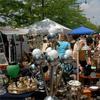


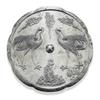
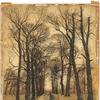
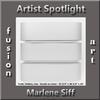
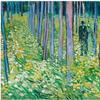
![Offering a Truce [Bested], 1895, is estimated to sell for between $1,300,000 and $1,800,000 on March 22, 2014, for The Russell: An Exhibition and Sale to Benefit the C.M. Russell Museum. Offering a Truce [Bested], 1895, is estimated to sell for between $1,300,000 and $1,800,000 on March 22, 2014, for The Russell: An Exhibition and Sale to Benefit the C.M. Russell Museum.](/images/c/a8/20/Dec10_Offering_a_Truce__Bested_300dpi100x100_c.jpg)
